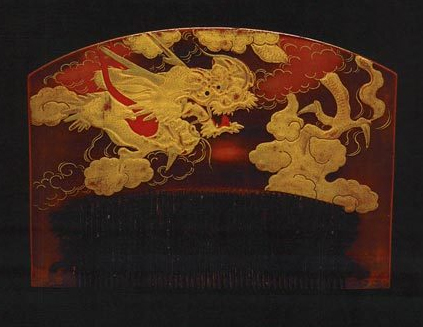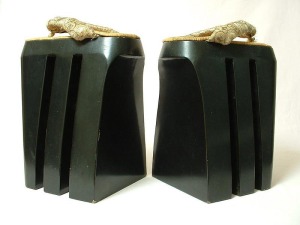From the Miriam Slater Collection, this set features an open-top kushi design filled with gold maki-e leaves, stems, and one mother-of-pearl bud. There is a scroll ornament painted on both sides. The kogai stick has the same scroll theme diagonally carated to separate the same leaf, stem, and bud theme on both ends. Stunning Edo style. c. 1800.
Category Archives: Edo Hair Comb
The Poetry of Emperor Yao
Ancient Chinese legends celebrate the wisdom, benevolence, and diligence of Emperor Yao (2356 – 2255 BC). In his poetry, he wrote, “The drum for raising alarms is now covered in deep moss, and the fowls are left undisturbed,” which referred to the drum he placed at his humble home’s gate. By speaking into it, his subjects could voice their concerns.
Japanese comb makers have portrayed Emperor Yao’s poem in both Edo and Meiji pieces, where a rooster guards the Emperor’s drum in a flower garden.
Here are two examples, both tortoiseshell painted with gold maki-e. The first is Edo from The Miriam Slater Collection, and the second is a Meiji comb for sale on Trocadero.
कंघी
For more scholarly research, please examine
The gigantic hair ornaments of oiran, Japan’s courtesans
Oiran or Japan’s highest ranking courtesans were the grandest and most spectacular women of the “floating world”. The word oiran means “first flower” which poetically indicates their exalted status in society. Like geisha they often had humble beginnings, and many were originally sold into the business as children and were left to work their way up over the years as apprentices. Oiran should not be confused with geisha whose dress was more subtle and simple. Oiran, known for their beauty, artistry and intelligence, dictated the fashions of the day and influenced many artists, poets and musicians. They are part of Japan’s cultural legacy and the famous oiran parade called the “oiran-dochu” is still re-enacted in Japan today. An oiran’s costume consists of many layers of thick padded kimonos along with a large ornate brocade obi tied in the front as was required in her profession. (Kimonos traditionally are tied in the back). She wore towering black lacquer geta which caused her to require assistance to walk. Her hair was arranged in an elaborate hair style with large hair ornaments artfully placed, displaying her rank and status. Objects worn by the oiran are hard to find these days, but I was lucky enough to obtain some of these tortoise pieces as well as this amazing pair of black lacquer shoes from the early 1900’s. One can only imagine the stories these pieces have to tell!
Miriam Slater: Tortoiseshell Combs
I do not know what to do with myself when I see what artist Miriam Slater has collected. My mind basically goes blank. However, my jaw does recover within the hour. Here are two picks from the tortoiseshell part of her Edo collection. The first wedding set features a tortoise and a crane, symbolizing stability and freedom. The second has the scroll of wisdom.
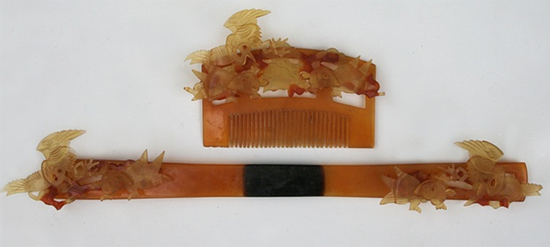
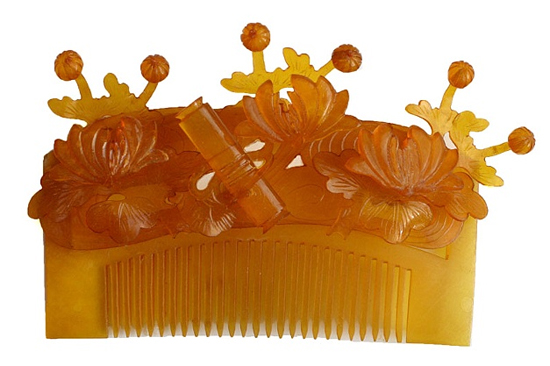
Edo Comb Set on Ebay
There is a lovely silver framed Edo set selling on Ebay for $1250. Using studs to attach the floral decoration to the kushi’s silver frame, the artist punctuates it with coral beads. The dealer dates the set as 1900 – 1920.
Here is why I am doubting his dates.
1. The size of the silver frame in relation to the comb looks Edo to me.
2. The comb itself is tortoiseshell, while the frame is silver.
3. The tortoiseshell comb has bug bites, a sign of age.
4. The floral design is attached to the comb instead of being cut out of one piece.
5. The cutting in the middle of the kogai stick is a line in the middle of two hearts, facing inward.
6. The kogai stick has the same decorative theme as the kushi. In modern pieces that mimic the Edo era, the kushi is usually accompanied by an oversized kanzashi, not a kogai stick.
7. Here is another silver Edo set that sold on ebay. In fact, I think it was my first blog post!
The full set selling on Ebay:
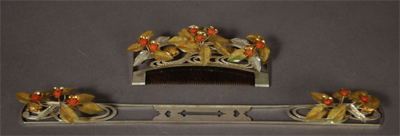
The kushi front and back, where you can see the floral design is attached.
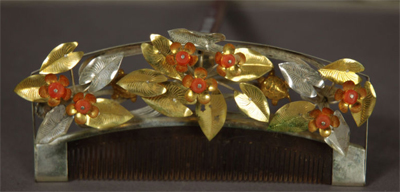
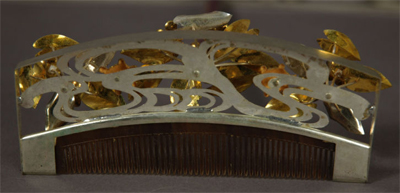
A similar set from Miriam Slater’s collection. Notice the cutting of the line in between two hearts on the kogai.
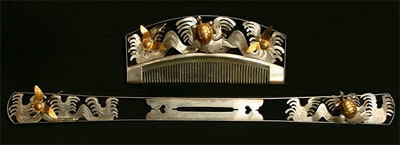
A piece from my collection: this is Taisho. The silver design, comb and theme of flowers in water, are all carved out of one piece of silver, and adorned with gilded brass and black for color. My set is accompanied by a kanzashi, not a kogai.
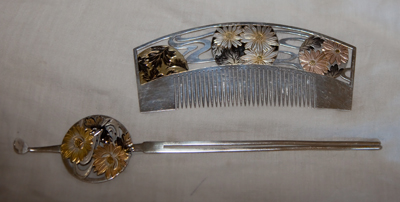
What does everyone think? Am I seeing this comb set correctly? Agreements / Disagreements welcome.
Jessica Beauchemin and Miriam Slater
I would like to welcome two new authors to our community blog.
An award-winning Canadian modern artist, Jessica Beauchemin creates balanced abstract wood sculptures, which I feel mirror the design sense of Alexander Calder.
Our second new author is Miriam Slater. We have had passionate conversations about Japanese hair ornaments for years, and she has put her collection online. When I saw what she had, I fainted. She will write about her own collection, as is proper, but as I have absolutely no emotional control, I must share three pieces. They are all Edo masterpieces, and I am sure Miriam will have more to say about her work in future posts.
Ivory Edo half-moon comb of plover birds sitting on a cherry tree branch, with blossoms.
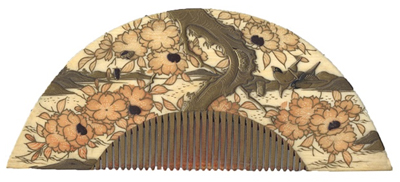
Tortoiseshell Edo comb of three carp swimming in the water. The carving on the fish is so detailed, they almost have human expressions.

Do you see how the turtle is looking from underneath the water at the birds flying above? The artist achieves this metaphor by hooking the birds to the kushi with silver finials and coral beads. Brilliant.
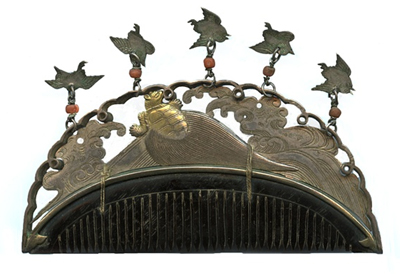
Kanzashi as Deadly Weapons
Brass- or gold-plated metal kanzashi began to be made in the latter part of the Edo era, when hair styles became more complicated. Hair ornaments revealed a woman’s class, marital status, age, and if she had any children.
A woman could also use her kanzashi as a deadly weapon. Female ninja, or kunoichi, practiced ninjutsu, the martial art of guerrilla warfare. They used their kanzashi to rake the eyes of their victims while escaping. Or, they dipped them in poison to assassinate people. Fending off male attackers was another convenient function.
This gold-plated skull kanzashi subtly illustrates beauty’s deadly side. It currently resides in the Daruma Museum
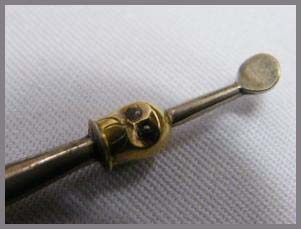
Tokugawa Shogunate Tortoiseshell Wedding Set
I have never seen a real tortoiseshell Japanese wedding set for sale. This one is not only the real thing, it comes in its original box, which has a family crest of three ivy leaves. This symbol was used on samurai flags and became popular after the 8th shogun of the Tokugawa family, who ruled the Edo era. Their trade policies isolated Japan and its art from the world. Earlier Tokugawa family crests used maple leaves. I am sure the price on this is high, but if you can afford it, I’d call this a buy. In this post I am including another hair comb with the maple-leaf logo of the Shogunate, which also sold on Trocadero.
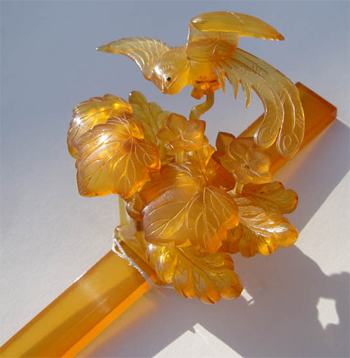
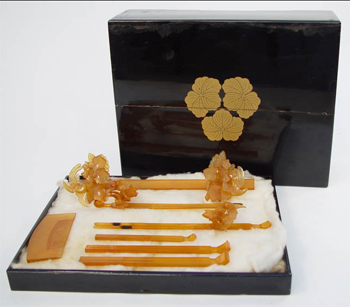
To compare the logo on the box to the family crest on a hair comb:
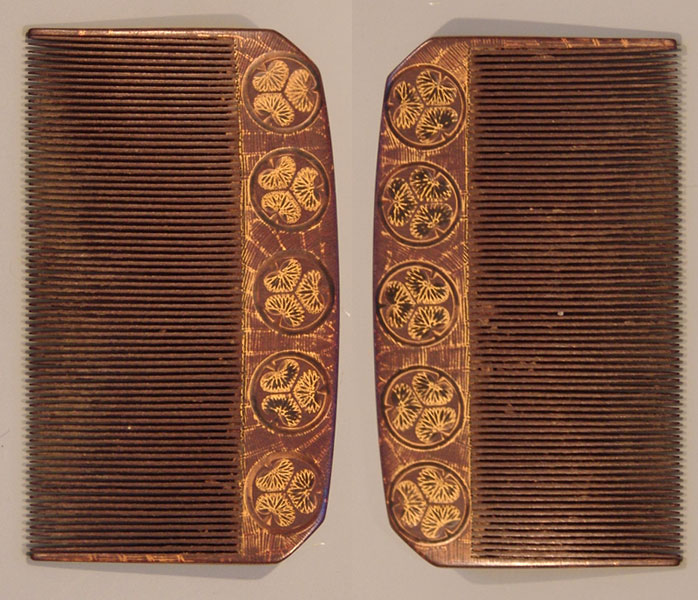
Some Early Edo Masterpieces
The Tokugawa Shogunate ruled Japan from 1637 to 1867. They closed the country to foreigners, and Japanese decorative arts remained a mystery to the Western World. Although porcelain continued to be exported, Japan did not come out of seclusion until the Meiji Era began in 1868. In the Paris Exposition of 1872, Western artists first saw early Edo combs. Japonisme began. Here are three early Edo masterpieces Paris artists might have seen. The style and shape of these combs gives the artist a large canvas, on which they paint one idea.
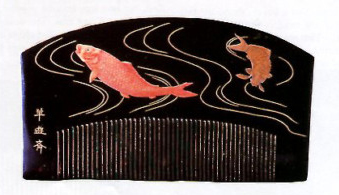
I believe this is a painted tortoiseshell comb of a tree branch extending over a lake. Insects are flying about. Where the artist reveals the tortoiseshell adds shadows to the insects. The fish painted on the tines represent the fish underneath the lake. Look at the shading blend from top to bottom. This is a masterpiece.
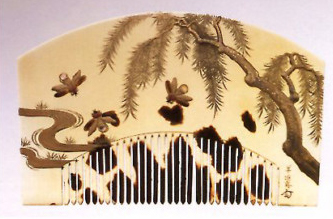
Edo artists painted on glass, too.
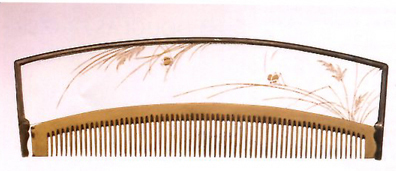
Edo Water God
18th-Century Edo comb. One idea: A dragon in the clouds. In Japanese mythology, dragons were water gods in charge of rainfall, lakes, rivers, and oceans. The serpentine dragon on this comb was typical — large and wingless, with clawed feet. The artist worked with the tortoiseshell’s natural color gradations, painting the dragon in the exact place where his tongue would be the deepest red.
